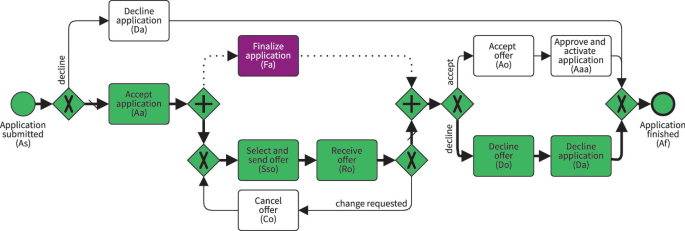Introduction: The Dance of Data and Process
Imagine a dance floor where each dancer represents an event in a business process—sales orders, approvals, shipments—all moving in rhythm with the organisation’s intended choreography. Yet, sometimes, a few dancers miss a beat, take an extra step, or spin too early. Conformance checking is the art of seeing how well that dance aligns with the choreography written in the process model. It’s not just about spotting errors—it’s about understanding where reality diverges from design.
In the realm of process mining, conformance checking alignment brings mathematical precision to this dance. It evaluates how closely real-world event logs correspond to the ideal process model, using optimal matching algorithms to find the best possible mapping between traces (the observed dance) and the model (the intended choreography).
Mapping Traces to Models: The Story of Alignment
At its core, alignment is about finding harmony between what actually happened and what should have happened. Think of it like comparing a musician’s live performance to the original sheet music. Some notes might be added, others skipped, but the goal is to measure how far the performance strays from perfection.
In process mining, this is achieved by mapping each event in a trace to a corresponding activity in the model. When they match, it’s like a perfect step in the dance. When they don’t, the algorithm identifies deviations—extra steps, missing moves, or mistimed sequences. The result is not just a binary “fit” or “no fit” but a detailed picture of where and why discrepancies occur.
Students exploring this in Data Analytics classes in Mumbai often see it as a blend of art and computation—a visual and logical way of tracing the journey of a process through data and deriving meaning from mismatched patterns.
Optimal Matching Algorithms: The GPS of Process Deviation
Now, imagine driving from one city to another using a GPS. There are countless possible routes, but you want the one that minimises travel time and cost. Optimal matching algorithms do the same for process alignment. They find the path through a process model that most efficiently matches an observed trace, even when there are detours or wrong turns.
The most common technique is based on cost minimisation. Every deviation—an unexpected event or missing action—carries a cost. The algorithm explores multiple potential alignments and calculates the total cost for each one. The alignment with the lowest price is considered optimal.
This process is not brute force guessing—it’s guided by principles from dynamic programming and operations research, ensuring that even in a labyrinth of process variations, the algorithm finds the most efficient route. The elegance lies in how these computational methods bring order to what appears chaotic in large-scale enterprise data.
Measuring Fitness: The Symphony of Accuracy and Deviation
Once alignment is achieved, the next step is evaluating fitness—the degree of harmony between the observed and the expected. Think of it as scoring a musical performance for pitch accuracy and timing. A perfect conformance score means the trace matches the model flawlessly; lower scores indicate off-key moments in execution.
But this measurement isn’t just about compliance. In a practical sense, fitness analysis reveals bottlenecks, redundancies, and opportunities for automation. For example, if an approval step frequently occurs after a shipment event, it might highlight a systemic procedural gap. Alignments thus become diagnostic tools for operational efficiency.
When learners in Data Analytics classes in Mumbai explore this concept, they see beyond theory—they witness how data reflects human and system behaviour within organisations. It’s like reading the hidden diary of a process, where every misalignment tells a story.
Beyond Fitness: Precision, Generalisation, and Simplicity
Alignment doesn’t stop at matching traces. Once fitness is known, analysts also consider precision (avoiding false positives), generalisation (ensuring the model isn’t too rigid), and simplicity (keeping the model interpretable). These pillars ensure that the process model remains both accurate and adaptable.
Precision prevents overfitting—a model that matches every noise in the data but fails to represent actual process logic. Generalisation ensures that the model can handle unseen but legitimate variations. Simplicity keeps the model usable, much like simplifying a complex piece of music without losing its essence.
By balancing these dimensions, process analysts create models that not only describe past behaviour but also anticipate future deviations—turning alignment into a tool for prediction and optimisation.
From Conformance to Continuous Improvement
The ultimate power of conformance checking lies in its ability to close the loop between discovery and enhancement. Once misalignments are identified, organisations can act—streamlining workflows, enforcing controls, or retraining employees. Over time, this creates a self-correcting feedback system.
Modern process mining platforms embed these alignment mechanisms into dashboards, allowing real-time deviation alerts and performance tracking. In industries like healthcare, finance, or logistics, such insights prevent costly errors and improve compliance with regulations.
As automation and AI deepen their roots in operational management, alignment algorithms serve as the backbone for intelligent process monitoring—bridging the gap between machine precision and human judgment.
Conclusion: Harmony Between Model and Reality
Conformance checking alignment is more than a computational challenge—it’s a philosophical pursuit of harmony between expectation and execution. Optimal matching algorithms act as silent conductors, ensuring that the symphony of business processes plays as intended.
By combining mathematical rigour with visual clarity, alignment transforms raw event logs into actionable intelligence. For today’s data-driven enterprises, it’s not just about measuring deviation—it’s about learning from it, refining the system, and moving closer to operational perfection.
In the grand performance of analytics and automation, alignment ensures that every dancer knows their step, every note strikes the right tone, and every process stays true to its rhythm.


